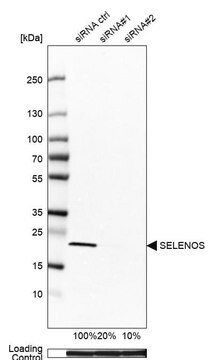推荐产品
生物源
rabbit
共軛
unconjugated
抗體表格
affinity isolated antibody
抗體產品種類
primary antibodies
無性繁殖
polyclonal
產品線
Prestige Antibodies® Powered by Atlas Antibodies
形狀
buffered aqueous glycerol solution
物種活性
human
加強驗證
independent
orthogonal RNAseq
recombinant expression
Learn more about Antibody Enhanced Validation
技術
immunoblotting: 0.04-0.4 μg/mL
immunohistochemistry: 1:50-1:200
免疫原序列
IEPKDIHAKCELAFLHTSHCLASGEVMISSLGDVKGNGKGGFVLLDGETFEVKGTWERPGGAAPLGYDFWYQPRHNVMISTEWAAPNVLRDGFNPADV
UniProt登錄號
運輸包裝
wet ice
儲存溫度
−20°C
目標翻譯後修改
unmodified
基因資訊
human ... SELENBP1(8991)
免疫原
Selenium-binding protein 1 recombinant protein epitope signature tag (PrEST)
應用
All Prestige Antibodies Powered by Atlas Antibodies are developed and validated by the Human Protein Atlas (HPA) project and as a result, are supported by the most extensive characterization in the industry.
The Human Protein Atlas project can be subdivided into three efforts: Human Tissue Atlas, Cancer Atlas, and Human Cell Atlas. The antibodies that have been generated in support of the Tissue and Cancer Atlas projects have been tested by immunohistochemistry against hundreds of normal and disease tissues and through the recent efforts of the Human Cell Atlas project, many have been characterized by immunofluorescence to map the human proteome not only at the tissue level but now at the subcellular level. These images and the collection of this vast data set can be viewed on the Human Protein Atlas (HPA) site by clicking on the Image Gallery link. We also provide Prestige Antibodies® protocols and other useful information.
The Human Protein Atlas project can be subdivided into three efforts: Human Tissue Atlas, Cancer Atlas, and Human Cell Atlas. The antibodies that have been generated in support of the Tissue and Cancer Atlas projects have been tested by immunohistochemistry against hundreds of normal and disease tissues and through the recent efforts of the Human Cell Atlas project, many have been characterized by immunofluorescence to map the human proteome not only at the tissue level but now at the subcellular level. These images and the collection of this vast data set can be viewed on the Human Protein Atlas (HPA) site by clicking on the Image Gallery link. We also provide Prestige Antibodies® protocols and other useful information.
生化/生理作用
Selenium-binding protein 1 is a protein encoded by the SELENBP1 gene in humans and is located on chromosome 1q21-22. It is referred as LPSB, SP56, hSBP, SBP56 and HEL-S-134P. It plays a critical role in prostate cells and is identified as a candidate anti-oncogene product. It may act as a potential pharmacological target for CRC treatment. Its expression is regulated by estrogen and its expression level may act as an important marker for predicting survival and effectiveness of selenium supplementation in breast cancer. It might also serve as a novel potential biomarker for early detection of squamous cell cancer (LSCC).
特點和優勢
Prestige Antibodies® are highly characterized and extensively validated antibodies with the added benefit of all available characterization data for each target being accessible via the Human Protein Atlas portal linked just below the product name at the top of this page. The uniqueness and low cross-reactivity of the Prestige Antibodies® to other proteins are due to a thorough selection of antigen regions, affinity purification, and stringent selection. Prestige antigen controls are available for every corresponding Prestige Antibody and can be found in the linkage section.
Every Prestige Antibody is tested in the following ways:
Every Prestige Antibody is tested in the following ways:
- IHC tissue array of 44 normal human tissues and 20 of the most common cancer type tissues.
- Protein array of 364 human recombinant protein fragments.
聯結
Corresponding Antigen APREST70248
外觀
Solution in phosphate-buffered saline, pH 7.2, containing 40% glycerol and 0.02% sodium azide
法律資訊
Prestige Antibodies is a registered trademark of Merck KGaA, Darmstadt, Germany
免責聲明
Unless otherwise stated in our catalog or other company documentation accompanying the product(s), our products are intended for research use only and are not to be used for any other purpose, which includes but is not limited to, unauthorized commercial uses, in vitro diagnostic uses, ex vivo or in vivo therapeutic uses or any type of consumption or application to humans or animals.
未找到合适的产品?
试试我们的产品选型工具.
儲存類別代碼
10 - Combustible liquids
水污染物質分類(WGK)
WGK 1
閃點(°F)
Not applicable
閃點(°C)
Not applicable
Jee-Yeong Jeong et al.
BMB reports, 47(7), 411-416 (2014-05-31)
In the present study, we demonstrate that ectopic expression of 56-kDa human selenium binding protein-1 (hSP56) in PC-3 cells that do not normally express hSP56 results in a marked inhibition of cell growth in vitro and in vivo. Down-regulation of
Sheng Zhang et al.
PloS one, 8(5), e63702-e63702 (2013-05-25)
Supplemental dietary selenium is associated with reduced incidence of many cancers. The antitumor function of selenium is thought to be mediated through selenium-binding protein 1 (SELENBP1). However, the significance of SELENBP1 expression in breast cancer is still largely unknown. A
P W Chang et al.
Journal of cellular biochemistry, 64(2), 217-224 (1997-02-01)
We have isolated the full-length human 56 kDa selenium binding protein (hSP56) cDNA clone, which is the human homolog of mouse 56 kDa selenium binding protein. The cDNA is 1,668 bp long and has an open reading frame encoding 472
Gu-Qing Zeng et al.
PloS one, 8(8), e71865-e71865 (2013-08-27)
Our quantitative proteomic study showed that selenium-binding protein 1 (SELENBP1) was progressively decreased in human bronchial epithelial carcinogenic process. However, there is little information on expression and function of SELENBP1 during human lung squamous cell cancer (LSCC) carcinogenesis. iTRAQ-tagging combined
Ning Wang et al.
Oncology reports, 31(6), 2506-2514 (2014-04-17)
The aim of the present study was to examine the regulation of selenium binding protein 1 (SELENBP1) expression in colorectal cancer (CRC). Samples of cancer tissue and adjacent normal mucosa were collected from 83 CRC patients, and analyzed for SELENBP1
我们的科学家团队拥有各种研究领域经验,包括生命科学、材料科学、化学合成、色谱、分析及许多其他领域.
联系技术服务部门









